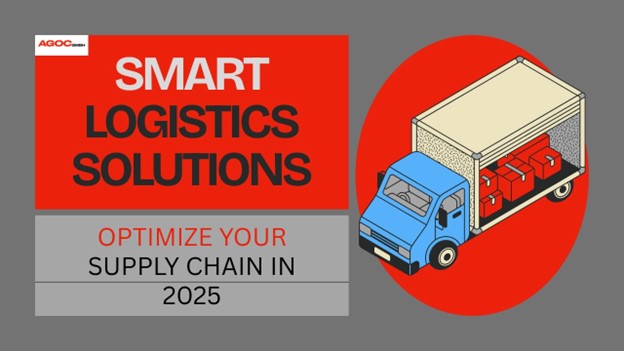

Explore smart logistics technologies in 2025 to optimize your supply chain with AI, IoT, automation, and sustainable solutions. Boost efficiency and cut costs.
Meta Title (60 characters):
Smart Logistics Solutions to Optimize Supply Chains 2025
Meta Description (160 characters):
Explore smart logistics technologies in 2025 to optimize your supply chain with AI, IoT, automation, and sustainable solutions. Boost efficiency and cut costs.

In 2025, businesses are under increasing pressure to deliver faster, cheaper, and greener. Traditional logistics methods can no longer meet these demands. That’s where smart logistics solutions come in—transforming the way businesses manage and optimize their supply chains through automation, AI, and real-time data. In this blog, we’ll explore the top smart logistics technologies shaping 2025 and how they can help you stay competitive.
Smart logistics refers to the integration of advanced technologies, like artificial intelligence, IoT, and cloud computing, into logistics operations to improve efficiency, accuracy, and agility across the supply chain. Unlike traditional methods, smart logistics systems leverage data to make real-time decisions, enabling businesses to optimize inventory, enhance visibility, reduce waste, and ensure timely deliveries.
AI enables demand forecasting, route optimization, and real-time decision-making. For example, Amazon uses AI-powered algorithms to predict product demand and adjust warehouse inventory levels before a customer even places an order, reducing shipping times.
Internet of Things (IoT) devices offer end-to-end visibility by tracking shipments, monitoring temperature-sensitive cargo, and notifying of delays or anomalies in real-time. DHL has implemented IoT sensors in its fleet to track shipments and monitor vehicle performance, significantly improving delivery accuracy.
Automated systems like robotic picking, conveyor belts, and drones streamline order fulfillment, reduce labor costs, and increase warehouse throughput. Ocado, a British online grocery retailer, uses robots to pick and pack customer orders with near-perfect precision.
Blockchain enhances trust and transparency in multi-party logistics networks by providing an immutable ledger for transactions, shipments, and documentation. Maersk and IBM’s TradeLens platform is a real-world example, enabling secure, real-time sharing of shipping data between stakeholders.
Cloud platforms centralize logistics operations, improve collaboration between partners, and scale quickly without large infrastructure investments. FedEx uses cloud-based systems to coordinate global logistics and provide real-time shipment updates to customers.
Smart logistics solutions offer measurable benefits across the supply chain:
Last-mile delivery accounts for over 50% of total shipping costs. Smart logistics addresses this with:
For example, UPS uses AI and GPS to plan delivery routes that save fuel and time, while Starship Technologies has deployed autonomous delivery robots in cities to fulfill local deliveries efficiently.
Sustainability is no longer optional—it’s a competitive necessity. Smart logistics plays a critical role in building environmentally friendly and socially responsible supply chains.
Switching to electric or hybrid delivery fleets reduces greenhouse gas emissions and lowers fuel costs. For example, companies like IKEA are committing to 100% electric delivery in major urban areas.
AI-powered route optimization minimizes mileage, idle time, and fuel use. This not only reduces environmental impact but also improves delivery efficiency and cost-effectiveness.
Use recyclable, compostable, or minimal packaging to decrease landfill waste. Smart logistics systems can suggest optimal package sizes to reduce material usage and shipping volume.
Implement energy-efficient lighting, HVAC systems, and automation in warehouses. Smart climate control systems can reduce energy consumption while maintaining optimal storage conditions.
Enable efficient returns processing and recycling through smart logistics platforms. Reverse logistics ensures that used or unsold products are refurbished, reused, or recycled, supporting a circular economy model.
Smart logistics systems help companies track and report environmental data, ensuring compliance with global sustainability standards like ISO 14001 and local emissions regulations.
Implementing smart logistics requires a clear strategy that aligns with your business goals. Here’s a detailed step-by-step approach:
Begin by auditing your existing logistics processes. Identify inefficiencies such as delivery delays, inventory mismanagement, or high labor costs. Use KPIs like order accuracy, delivery time, and customer satisfaction to pinpoint areas that need improvement.
Define what you aim to achieve with smart logistics—whether it’s reducing costs, increasing speed, improving visibility, or supporting sustainability. Setting SMART (Specific, Measurable, Achievable, Relevant, Time-bound) goals will help guide your implementation.
Choose scalable and flexible technologies that match your needs:
Evaluate vendors based on integration capabilities, support, scalability, and ROI.
Ensure your new logistics tools integrate seamlessly with existing ERP, CRM, and inventory management systems. Data integration enables real-time decision-making and eliminates silos.
Provide comprehensive training to employees to ensure they understand how to operate and leverage new systems effectively. Encourage a culture of innovation and continuous learning.
The logistics landscape in 2025 demands agility, intelligence, and sustainability. By adopting smart logistics solutions, your business can cut costs, improve efficiency, and stay ahead of the competition.
Smart logistics solutions integrate technologies like AI, IoT, cloud computing, and automation to optimize supply chain processes. They enable real-time decision-making, inventory management, and efficient delivery systems.
AI enhances logistics by predicting demand, optimizing delivery routes, and automating warehouse operations. In 2025, it will help businesses reduce costs, speed up delivery, and improve accuracy.
IoT enables real-time tracking of shipments, condition monitoring (e.g., temperature-sensitive cargo), and proactive maintenance alerts. It ensures visibility and minimizes disruptions in the supply chain.
Warehouse automation reduces labor costs, speeds up order fulfillment, and increases accuracy. Technologies like robotics and conveyor systems streamline operations and boost productivity.
Blockchain creates a secure, tamper-proof ledger of logistics transactions. It increases trust and transparency among stakeholders, especially in global and multi-party supply chains.
Cloud logistics platforms offer centralized control, real-time updates, and easy scalability. They improve collaboration and allow businesses to adapt quickly to market changes.
Smart logistics uses AI route planning, real-time tracking, and micro-fulfillment centers to optimize last-mile deliveries. This reduces fuel usage and improves delivery speed and customer satisfaction.
By using electric vehicles, optimizing routes, and reducing packaging waste, smart logistics helps cut carbon emissions and supports eco-friendly supply chain practices.
AGOC GMBH Golden Quartier, Tuchlauben 7A 1010 , Wien, Austria UID-NR.ATU79754589 , FN 608734 y